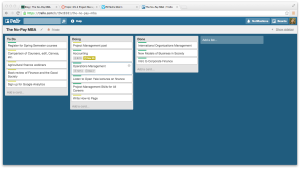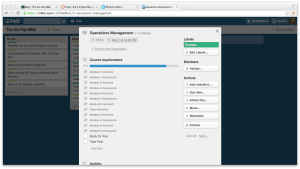As first semester comes to a close, I will soon be enrolled in only one course. New Models of Business in Society ended a while back, International Organizations Management also wrapped up several weeks ago, and I’m preparing for finals in my two Wharton courses – Operations Management and Accounting. Until Spring Semester starts, my only course will be Project Management Skills for All Careers, through Canvas Network. It’s good timing for a lightened course load, since I just started a new job – hooray! (More on that in a future post.)
Project management is kind of my thing. Even though I haven’t studied it formally until now, project management is the bread and butter of my professional life. I am the type of person who gets truly excited about a well-designed spreadsheet, and creating a color-coded calendar is the type of thing I might do for fun, so I was a bit skeptical that this intro course geared towards accidental project managers would have anything to offer me.
I’m pleasantly surprised that already in the first two modules of my Canvas course we have covered some material that I have found interesting and enlightening.
The Difference Between Project Management and Operations Management
First, I was pleased to get a definition for project management as opposed to other kinds of management. To paraphrase from the textbook we are using for the course - a digital book with the same name as the course itself:
A project is temporary in nature and geared towards producing a unique outcome. It ends once it has met its goals and objectives or is cancelled if those goals and objectives cannot be met.
Managing a project is quite different from managing an ongoing process. The latter was the topic of my course in Operations Management, which was geared towards finding efficiencies in processes that are repeated again and again, over an indefinite period of time. In contrast, a project happens only once, so much of it is created new and is specific to the task at hand.
The Three Pillars of Project Management
Second, the course offered a helpful set of key considerations in any project, which are referred to as the three pillars of project management. These are:
- Cost,
- Schedule, and
- Scope/quality.
Inherent tradeoffs exist among these three pillars, as exemplified in this sign that was printed in our textbook, said to have come from an auto repair shop:
We do GOOD, CHEAP, and QUICK work.
You can have any two but not all three.
GOOD QUICK work won’t be CHEAP.
GOOD CHEAP work won’t be QUICK.
QUICK CHEAP work won’t be GOOD.
Visual Project Management
Third, and best of all, the course jumped right into practical techniques for managing projects. The method they started with is called visual project management. Imagine a white board with cards that represent tasks that must be completed as part of the project. The cards are organized into three columns: To Do, Doing, and Done. Several free web-based software programs offer virtual whiteboards and cards. I have started using one called Trello, and I am absolutely in love with it.
Here, you can see how I am organizing the No-Pay MBA. Cards with a green label are for courses, and those with a yellow label are for blog-related items.
If you click on any of these cards, the back of the card offers many other tools including checklists, deadlines, color-coded labels, email notifications, etc.
I’m excited to see where Project Management for All Careers goes next, but even if I don’t get anything else out of the course, I’ve gotten my money’s worth – and I’d feel the same even if the course weren’t free.





